


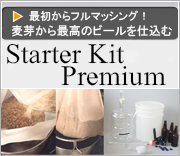
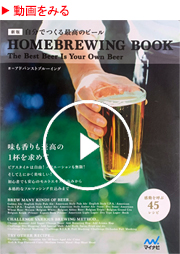
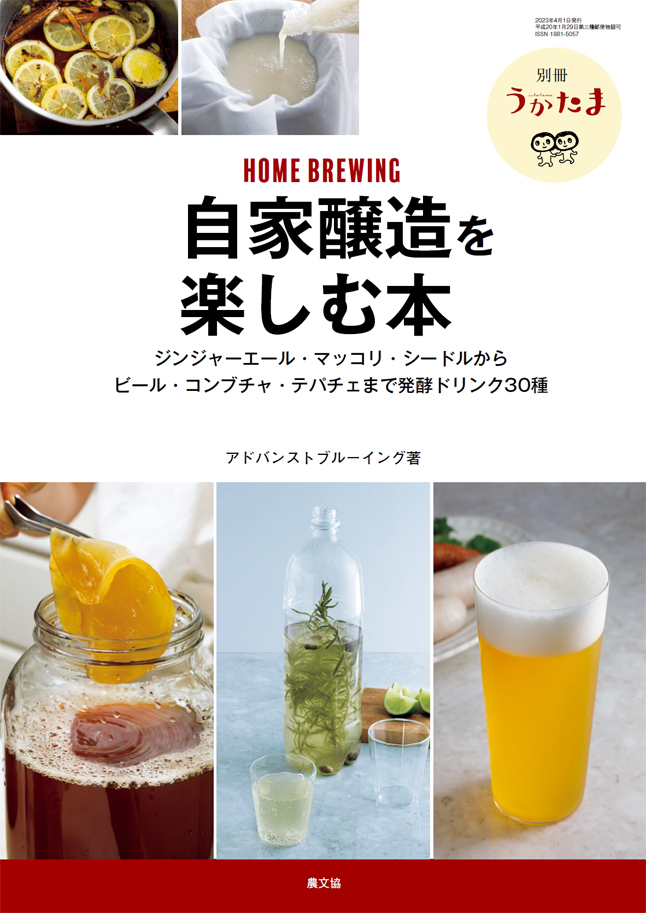
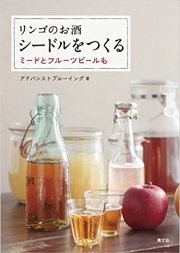


■ビールキット(材料セット)
Beer Kits(Ingredient Set)

日曜・祭日も営業しております
|
 |
 |
Wyeastインフォメーション |
 |
・はじめに
・イーストの成長サイクル
・Wyeastの保存方法
・Wyeastの構造と使い方
・スタータとは
・スタータの量
・スタータの作り方
・スタータの投入タイミング
・Wyeastの再利用
・Wyeast選定ガイド#1
・Wyeastの種類
・Wyeast選定ガイド#2
・Wyeast選定ガイド#3
はじめに
EDMEや特に最近出回っているDCL(現Fermentis)などの高品質のドライイーストは、リキッドイーストにほとんど劣ることのない美味しいビールを造ることができます。例えば私がこれまでに一番美味しいと感じたhomebrewingビールは、あるhomebrewerからいただいたアンバーエール。EDMEのドライイーストを使ったものでした。
EDMEのドライエールイーストは発酵終了直後の香りこそ、リキッドイーストの香りに比べると酵母臭が強いため、劣っているように思われがちです。しかし半月以上の熟成により、リキッドイーストに比べての優劣がつけ難くなくなります。
さらにDCL(現Fermentis)のドライイーストでは、発酵終了直後の香りも他のドライイースト特有の酵母臭がなく、非常に優れたものです。また、DCL(現Fermentis)のドライラガーイーストは、従来のラガーイーストでは不可能であった真のラガー発酵温度帯(10℃以下)での発酵が可能である、従来の常識を覆すイーストです。
ドライイーストはスタータを作る必要が無く保存も容易、「変質」の危険性もきわめて少ないことから、昨今では日本や海外の地ビールメーカでも広く使われ始めています。
これら優れたドライイーストがありながら、Wyeast(リキッドイースト)にはドライイーストには代え難い非常に大きな魅力があります。それは実に50種類近くに及ぶ種類の豊富さです。ボディ、コクが強いビール、ドライですっきりとしたビール、フルーティで複雑な芳香のビール、ヴァィツェンのようにバナナ・クローブのような芳香のあるビール、ラガーでありながら高温で発酵させ独特なフレイバーを得るスティームビア、乳酸菌や野生酵母がブレンドされ独特な酸味があるランビックビール・・・実に様々な種類のイーストがラインアップされています。
Wyeastのもう一つの魅力は再利用が可能なこと。適切に扱えば5回以上の連続使用が可能です。
ドライイーストとリキッドイースト。それぞれの特長をふまえ、状況に応じて使い分けることで、より素晴らしいビールを造ってください。
イーストの成長サイクル
「増殖」フェーズ
イーストを投入後、ウォート中に酸素があるとイーストは増殖を始めます。ウォート1ml中の細胞数は最大1億個にまで達します。増殖に際しては細胞内に蓄えた栄養素を消費するため、このフェーズ後半のイーストは貧栄養状態にあります。したがって、このタイミングでイーストをウォートへ投入した場合、健全な発酵は望めません。
「発酵」フェーズ
イースト投入後6〜24時間、増殖によりウォート中の酸素を消費し尽くすと、次第に発酵が盛んになります。イーストは発酵により、ウォート中の糖分をアルコールと炭酸ガスに分解します。このフェーズでイーストは「増殖」で消費した栄養素をウォートから再び細胞内に取り込みます。
「凝集」フェーズ
発酵によりウォート中の糖分を消費すると、イースト同士が集合密着し凝集、沈殿します。
Wyeastの保存方法
必ず冷蔵庫で保存してください。室温での放置や急激な温度変化もできるだけ避けてください。
冷凍保存はできません。
使用できる目安は製造後6〜12ヶ月です。
製造年月日はパッケージ上部あるいは下部に刻印されています。
Wyeastの構造と使い方
構造
外側の金色のパッケージの中にさらに小袋があり、ウォート・イースト菌・酸素等が隔離された状態で入っています。パッケージ中の小袋を破ることにより(外側のパッケージは破りません)、パッケージ内でウォート・イースト菌・酸素が混ざり合い、無菌状態のままでイーストの発酵が始まります。
使い方
1.パッケージの製造年月日の刻印を見て、「パンチ」から「ウォートへ投入可能」となるまでのおよその日数を確認します。この日数はイーストの保存状態や菌種によっても変動します。
製造日から1ヶ月以内: 6時間〜24時間
製造日から2ヶ月以内: 12時間〜36時間
以降、1ヶ月古くなる毎に24時間増加
2.仕込み予定の日時から逆算して「パンチ」の日時を決めます。
3.「パンチ」の方法
1)丈夫で安定した平らな台、あるいは床のうえにパッケージを置き、パッケージの上に両方の掌を重ねて置きます。
2)一気に体重をかけ、パッケージ内部の小袋を破ります。
3)パッケージを外側からしごき、小袋の内容物を完全にパッケージ内に出してしまいます。
4)パッケージを激しく振って、パッケージ内のウォートを十分にエアレーションします。エアレーションは5分おきに3回程度続けてください。
5)室温(理想的にはエールでは24℃、ラガーでは18℃)に放置します。
 6)内部のイーストが発酵し、パッケージが十分膨らんだら(写真右)、「ウォート投入可能」です。このタイミングを逃さずにスタータか本ウォートに投入します。投入のために外側のパッケージを開封する際には、パッケージ外側やハサミなど、イーストに直接触れる可能性がある部分をアルコールか塩素計漂白剤で殺菌します。 6)内部のイーストが発酵し、パッケージが十分膨らんだら(写真右)、「ウォート投入可能」です。このタイミングを逃さずにスタータか本ウォートに投入します。投入のために外側のパッケージを開封する際には、パッケージ外側やハサミなど、イーストに直接触れる可能性がある部分をアルコールか塩素計漂白剤で殺菌します。
なお、パッケージが早く膨らみすぎ、仕込みが間に合わない場合は、(仮に本ウォートに投入予定であったとしても)一旦スタータを作り、こちらに投入することでタイミングを調整します。
パッケージを比較的低温に置くことで膨らむスピードを遅らせることもできます。ただし、この場合は冷蔵庫に入れることはできるだけ避けてください。特にラガーイーストの場合は急激な温度変化によりヒートショックを起こすことがあります。
スタータとは
スタータとは、仕込み前に予め予備発酵させた少量のウォートのことです。この発酵中のウォートを本ウォートに投入します。リキッドイーストではパッケージ内に生存する菌数が少ないため、予めスタータを作り、健全な発酵に必要な菌数を確保することが重要になります。
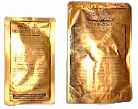 スタータの量 スタータの量
必要なスタータの量の目安を下表に示します。理想的なスタータの量はイーストのコンディションやウォートの温度、その他の要因によって変わります。
必要なスタータの量の目安(ml)
| 仕込量 |
ビールの種類 |
Wyeastのパッケージサイズ |
| 50mlサイズ |
XL(125ml)サイズ |
| 5リットル |
初期比重1.056までの標準的なエール |
不要 |
不要 |
| 初期比重1.064までの高度数エール |
不要 |
不要 |
| 初期比重1.056までの標準的なラガー |
不要 |
不要 |
| 初期比重1.064までの高度数ラガー |
不要(推奨500ml) |
不要 |
| 10リットル |
初期比重1.056までの標準的なエール |
不要(推奨250ml) |
不要 |
| 初期比重1.064までの高度数エール |
500ml以上 |
不要(推奨500ml) |
| 初期比重1.056までの標準的なラガー |
500ml以上 |
500ml以上 |
| 初期比重1.064までの高度数ラガー |
1000ml以上 |
1000ml以上 |
| 19リットル |
初期比重1.056までの標準的なエール |
500ml |
不要 |
| 初期比重1.064までの高度数エール |
1000ml以上 |
1000ml以上 |
| 初期比重1.056までの標準的なラガー |
1000ml以上 |
不要(推奨1000ml) |
| 初期比重1.064までの高度数ラガー |
2000ml以上 |
2000ml以上 |
*:初期比重がそれぞれ1.064・1.072・1.082を超えるビールでは、初期比重1.056までの標準的なエール・ラガーのスタータ量の3・4・5倍以上に増やします。
この場合、本ウォートに比べスタータの量の割合が大きくなり過ぎるため、「Wyeastの再利用」による澱の使用をお勧めします。
スタータの作り方
必要なスタータの量が決まったら、モルトエキスかドライモルトで比重1.030(1.020〜1.040)のスタータ用のウォートを作ります。比重1.030のウォートを作る配合を下表に示します。
比重1.030のスタータを作る時に必要なモルトエキスの量
| スタータの量 |
モルトエキス使用時 |
ドライモルト使用時 |
| 100ml |
10.3g |
8.0g |
| 200ml |
20.6g |
16.0g |
| 300ml |
30.9g |
24.0g |
| 400ml |
41.2g |
32.0g |
| 500ml |
51.5g |
40.0g |
| 1000ml |
103g |
80.0g |
| 1500ml |
155g |
120g |
| 2000ml |
206g |
160g |
1.上記量のモルトエキスかドライモルトに水(スタータの量+沸騰による蒸発分)を加え、殺菌のため15分間以上煮沸し、スタータ用のウォートとします。
2.このウォートを、煮沸消毒やアルコール等により滅菌した容器(発酵の様子を観察しやすいように、できれば透明な容器をお勧めします)に移します。容器の口から雑菌が入らないよう、アルミホイルやラップでしっかりと蓋をします。
3.ウォートが室温にまで冷めたら、十分に膨らんだWyeastの外側のパッケージを破りウォート中に投入します。投入したら容器ごと激しく振って十分エアレーションします。
4.容器の口から雑菌が入らないように、エアーロックをつけるか、あるいはアルミホイルやラップで緩く(発生する炭酸ガスが逃げるように)蓋をします。
5.6〜12時間後、発酵がピークに達したらスタータの完成です。
・砂糖や蜂蜜はイーストの成長に必要な栄養素が欠如しているため、スタータ用の糖としては不適です。日本の手造りビールの本によくでている「レモン汁を加える・・」も雑菌汚染の原因になるだけですので止めましょう。
・ペレットホップを通常のウォートよりも多めに(3倍ほどの濃度で)加えると、雑菌に対する抗菌作用が期待できます。
・比重1.040以上の濃いウォートはイーストにとってストレスが大きいため、スタータとして適していません。イーストの細胞内とウォートとの浸透圧の差が大きく、イーストが細胞内に栄養素を取り入れることが難しくなるためです。
スタータの投入タイミング
スタータの発酵がピーク(泡の発生が最も盛んな時期)に達した状態でスタータの容器を振ってかき回し、本ウォートに投入します。スタータの量が多い場合、上澄みのビールを捨て沈殿したイーストのみを投入することもありますが、基本的にはスタータの液体を全部投入します。
発酵ピーク前(泡が出始めたころ)のイーストは、その細胞内に健全な発酵のために必要な栄養素が不足した状態にあります。仮にこの状態で本ウォートに投入した場合、健全な発酵が期待できません。ウォートに投入したら直ちに発酵容器を激しく揺すり、十分なエアレーションを行います。
Wyeastの再利用
Wyeastは単一菌種を培養したピュアなイーストであるため、発酵後に沈殿した澱を次回の仕込みに再利用することができます。
1.再利用の方法
発酵が終了し、澱引きあるいは瓶詰め後に発酵容器に残った泥状の澱を滅菌した容器にとり、これを次回の仕込みの本ウォートに直接投入します。澱はまだゆっくりと発酵しているため、容器を密閉すると破裂することがあります。
・澱は必ず冷蔵庫で保存します。2週間くらいまで、そのまま使用できます。
・澱引きあるいは瓶詰め後、澱が発酵容器に残った状態のままで、この容器に次の本ウォートを注ぐことも可能です。
2.再利用の際に必要な澱の量
再利用の際に必要な澱の量の目安(ml)
| 仕込量 |
ビールの種類 |
必要な澱の量 |
| 5リットル |
初期比重1.056までの標準的なエール |
25ml以上 |
| 初期比重1.064までの高度数エール |
50ml以上 |
| 初期比重1.056までの標準的なラガー |
50ml以上 |
| 初期比重1.064までの高度数ラガー |
100ml以上 |
| 10リットル |
初期比重1.056までの標準的なエール |
50ml以上 |
| 初期比重1.064までの高度数エール |
100ml以上 |
| 初期比重1.056までの標準的なラガー |
100ml以上 |
| 初期比重1.064までの高度数ラガー |
200ml以上 |
| 19リットル |
初期比重1.056までの標準的なエール |
100ml以上 |
| 初期比重1.064までの高度数エール |
200ml以上 |
| 初期比重1.056までの標準的なラガー |
200ml以上 |
| 初期比重1.064までの高度数ラガー |
400ml以上 |
*:初期比重がそれぞれ1.064・1.072・1.082を超えるビールでは、初期比重1.056までの標準的なエール・ラガーの澱の量の量の3・4・5倍以上に増やします。
Wyeast選定ガイド#1
次の指標を参考に、Wyeastの種類からお好みにあったWyeastを選定してください。
1.基本的な分類:
ラガー、エール、ハイブリッド(酵母菌+乳酸菌)、ワイン、ミード、SAKE(日本酒)
2.基本的な性質:
味や香り、その他の特記事項が記載されています。
3.発酵温度:
推奨する発酵温度が記載されています。ただし゜F(Fahrenheit)表記のため、次式による℃(Centigrade)への換算が必要です。 ℃=(゜F−32)/1.8
例: 55゜F−> (55−32)/1.8=12.8℃
・ウォート温度が下限の発酵温度よりも低い場合、増殖〜発酵が停滞します。
・逆に上限の発酵温度よりも高い場合はエステリー(フルーティ、雑味の多い)フレイバー等が増加します。
4.希薄化レベル apparent attenuation:
発酵によりウォート中の糖分をどこまで分解できるかの指標です。
希薄化レベルが高いイーストでは終了比重が小さくなるためドライなビールになり、希薄化レベルが低いイーストでは終了比重が大きくなるため、ボディが強く、モルティなビールになります。
5.沈殿凝集性 Flocculation:
発酵後期にイースト同士が集合密着して沈殿する性質の強弱(high-low)の指標です。
「high」の場合、透明度の高いビールが得られますがこの性質が強すぎると、完全に発酵を終了する前に大半のイーストが沈殿してしまうため、甘みの残るビールになることがあります。また、一次発酵終了〜プライミングまでの期間を長く取るとビン内に入るイーストの数が少なくなるため、ビン内発酵に時間がかかる場合があります。
プライミングによる瓶内発酵の必要がない樽詰めの場合、沈殿凝集性の高いイーストを使い、低温で熟成させることで驚くほど透明度の高いビールになります。
「low」の場合、濁りが残りやすくなります。濁りが好まれる小麦系のビールでは沈殿凝集性の低いイーストを使います。
Wyeastの種類 (Wyeast社のホームページより転載)
ALE YEAST
1007 German Ale yeast
Ferments dry and crisp, leaving a complex but mild flavor. Produces an
extremely rocky head and ferments well down to 55o F. Flocculation low;
apparent attenuation 73-77%. (55-66o F)
1010 American Wheat yeast
A dry fermenting, true top cropping yeast which produces a dry, slightly
tart, crisp beer, in American hefeweisen style. Flocculation low, apparent
attenuation 74-78%. (58-74o F)
1028 London Ale yeast
Rich with a dry finish, minerally profile, bold and crisp, with some fruitiness.
Flocculation medium; apparent attenuation 73-77%. (60-72o F)
1056 American Ale yeast
Used commercially for several classic American ales. This strain ferments
dry, finishes soft, smooth and dean, and is very well balanced. Flocculation
low to medium; apparent attenuation 73-77%. (60-72o F)
1084 Irish Ale yeast
Slight residual diacetyl and fruitiness; great for stouts. Clean, smooth,
soft and full-bodied. Flocculation medium; apparent attenuation 71-75%.
(62-72o F)
1098 British Ale yeast
From Whitbread. Ferments dry and crisp, slightly tart, fruity and well-balanced.
Ferments well down to 65oF. Flocculation medium; apparent attenuation 73-75%.
(64-72o F)
1099 Whitbread Ale yeast
A mildly malty and slightly fruity fermentation profile; not as tart and
dry as 1098 and much more flocculant. Clears well without filtration. Flocculation
high; apparent attenuation 68-72%. (64-75o F)
1187 Ringwood Ale yeast
Notorious Yeast of European origin with unique fermentation and flavor
charateristics. Distinct fruit ester and high flocculation provide a malty
complex profile, which clears well. Thorough diacetyl rest is recommended
after fermentation is complete. Flocculation high; apparent attenuation
68-72%. (64-74o F)
1214 Belgian Ale yeast
Abbey-style top-fermenting yeast, suitable for high-gravity beers. Estery.
Flocculation medium; apparent attenuation 72-76%. (58-68o F)
1272 American Ale yeast ll
Fruitier and more flocculant than 1056, slightly nutty, soft, clean, slightly
tart finish. Flocculation high; apparent attenuation 72-76%. (60-72o F)
1275 Thames Valley Ale yeast
Produces classic British bitters, rich complex flavor profile, clean, light
malt character, low fruitiness, low esters, well-balanced. Flocculation
medium; apparent attenuation 72 76%. (62-72o F)
1318 London Ale yeast lll
From traditional London brewery with great malt and hop profile. True top
cropping strain, fruity, very light, soft balanced palate, finishes slightly
sweet. Flocculation - high; apparent attenuation 71-75%. (64-74o F)
1332 Northwest Ale yeast
One of the classic ale strains from the Northwest U.S. Breweries. Produces
a malty and mildly fruity ale with good depth and complexity. Flocculation
- high; apparent attenuation 67-71%. (65-75o F)
1335 British Ale yeast ll
Typical of British and Canadian ale fermentation profile with good flocculating
and malty flavor characteristics, crisp finish, clean, fairly dry. Flocculation
high; apparent attenuation 73-76%. (63-75o F)
1338 European Ale yeast
From Wissenschaftliche in Munich. Full-bodied complex strain finishing
very malty. Produces a dense, rocky head during fermentation. Flocculation
high; apparent attenuation 67-71 %. (62-72o F)
1388 Belgian Strong Ale yeast
Robust flavor yeast with moderate to high alcohol tolerance. Fruity nose
and palate, dry, tart finish. Flocculation low; apparent attenuation 73-77%.
(65-75o F)
1728 Scottish Ale yeast
Ideally suited for Scottish-style ales, and high gravity ales of all types.
Flocculation high; apparent attenuation 69-73%. (55-70o F)
1762 Belgian Abbey Yeast II
High gravity yeast with distinct warming character from ethanol production.
Slightly fruity with dry finish. Flocculation medium; apparent attenuation
73-77%. (65-75o F)
1968 London ESB Ale yeast
Highly flocculant top-fermenting strain with rich, malty character and
balanced fruitiness. This strain is so flocculant that additional aeration
and agitation is needed. An excellent strain for cask-conditioned ales.
Flocculation high; apparent attenuation 67-71%. (64-72o F)
2565 Kolsch yeast
A hybrid of ale and lager characteristics. This strain develops excellent
maltiness with subdued fruitiness, and a crisp finish. Ferments well at
moderate temperatures. Flocculation low; apparent attenuation 73-77%. (56-64o
F)
LAGER YEAST
2007 Pilsen Lager yeast
A classic American pilsner strain, smooth, malty palate. Ferments dry and
crisp. Flocculation medium; apparent attenuation 71-75%. (48-56o F)
2035 American Lager yeast
Bold, complex and aromatic, good depth of flavor characteristics for a
variety of lager beers. Flocculation medium; apparent attenuation 73-77%.
(48-58o F)
2042 Danish Lager yeast
Rich, dortmund-style, crisp, dry finish. Soft profile accentuates hop characteristics.
Flocculation low; apparent attenuation 73-77%. (46-56o F)
2112 California Lager yeast
Particularly suited for producing 19th century-style West Coast beers.
Retains lager characteristics at temperatures up to 65o F, and produces
malty, brilliantly-clear beers. Flocculation high; apparent attenuation
67-71 %. (58-68o F)
2124 Bohemian Lager yeast
A pilsner yeast from the Weihenstephen. Ferments clean and malty, with
rich residual maltiness in full gravity pilsners. Flocculation medium;
apparent attenuation 69-73%. (48-58o F)
2206 Bavarian Lager yeast
Used by many German breweries to produce rich, full-bodied, malty beers.
Good choice for Bocks and Dopplebocks. Flocculation medium; apparent attenuation
73-77%. (46-58o F)
2247 European Lager yeast ll
Clean dry flavor profile often used in aggressively hopped pilsner. Mild
aromatics, slight sulpher production, dry finish. Flocculation low; apparent
attenuation 73-77%. (46-56o F)
2272 North American Lager yeast
Traditional culture of North American and Canadian lager and light pilsners.
Malty finish. Flocculation high; apparent attenuation 70-76%. (48-56o F)
2278 Czech Pils yeast
Classic pilsner strain from the home of pilsners for a dry, but malty finish.
The perfect choice for pilsners and bock beers. Sulfur produced during
fermentation dissipates with conditioning. Flocculation medium to high;
apparent attenuation 70-74%. (48-58o F)
2308 Munich Lager yeast
A unique strain, capable of producing fine lagers. Very smooth, well-rounded
and full-bodied. Benefits from temperature rise for diacetyl rest. Flocculation
medium; apparent attenuation 73-77%. (48-56o F)
WHEAT YEAST
3068 Weihenstephan Weizen yeast
Unique top-fermenting yeast which produces the unique and spicy weizen
character, rich with clove, vanilla and banana. Best results are achieved
when fermentations are held around 68o F. Flocculation low; apparent attenuation
73-77%. (64-75o F)
3333 German Wheat yeast
Subtle flavor profile for wheat yeast with sharp tart crispness, fruity,
sherry-like palate. Flocculation high; apparent attenuation 70-76%. (63-75o
F)
3463 Forbidden Fruit yeast
From classic Belgian brewery for production of wits to classic grand cru.
Phenolic profile with subdued fruitiness. Seasonal availability. Flocculation
low; apparent attenuation 73-77%. (63-76o F)
3522 Belgian Ardennes yeast
One of many great beer yeasts to produce classic Belgian ales. Phenolics
develop with increased fermentation temperatures, mild fuitiness and complex
spicy character. Flocculation high; apparent attenuation 72-76%. (65-85o
F)
3638 Bavarian Wheat yeast
Top cropping hefeweisen yeast with complex flavor and aroma. Balance of
banana and bubble gum esters with lichi and apple/plum esters and cloveness.
Flocculation low; apparent attenuation 70-76%. (64-75o F)
3787 Trappist High Gravity
Robust top cropping yeast with phenolic character. Alcohol tolerance to
12%. Ideal for Biere de Garde. Ferments dry with rich ester profile and
malty palate. Flocculation medium; apparent attenuation 75-80%. (64-78o
F)
3942 Belgian Wheat yeast
Estery low phenol producing yeast from small Belgian brewery. Apple and
plum like nose with dry finish. Flocculation medium; apparent attenuation
72-76%. (64-74o F)
3944 Belgian Witbier yeast
A tart, slightly phenolic character capable of producing distinctive witbiers
and grand cru-style ales alike. Alcohol tolerant. Flocculation medium;
apparent attenuation 72-76%. (62-75o F)
BRETTANOMYCES & LACTIC CULTURES
−乳酸菌や野生酵母のブレンドによる酸味が特徴です−
3278 Belgian Lambic blend
Contains a selection of Saccharomyces cerevisiae which include Blegian
style wheat beer yeast, sherry yeast, two Brettanomyces strains and Lactic
Acid Bacteria. While this mixture does not include all possible cultures
found in Belgian Lambics, it is representative of the organisms which are
most important for the desirable flavor components of these beer styles.
Individual components available from this blend are numbered below. Flocculation
low to medium; apparent attenuation 65-75%. (63-75o F)
3112 Brettanomyces bruxellensis
Wild yeast isolated from brewery cultures in the Brussels region of Belgium.
Produces the classic sweaty horse hair character indigenous to beers of
this region; gueuze, lambics, sour browns. Ferments best in worts with
lower pH after primary fermentation has begun. This strain is generally
used in conjunction with S. Cerevisiae as well as other wild yeast and
lactic bacteria. Produces some acidity and may form a pellicle in bottles
or casks. Generally requires 3-6 months aging for flavor to fully develop.
Flocculation medium; apparent attenuation low. (60-75o F)
3526 Brettanomyces lambicus
Wild yeast isolated from Belgian lambic beers. Produces a pie cherry like
flavor and sourness along with disticnt brett character. Ferments best
in worts with reduced pH after primary fermentation has begun, and may
form a pellicle in bottles or casks. Works best in conjunction with other
yeast and lactic bacteria to produce the classic Belgian character. Generally
requires 3-6 months of aging to fully develop flavor characteristics. Flocculation
medium; apparent attenuation low. (60-75o F)
4335 Lactobacillus delbrueckii
Lactic acid bacteria isolated from a Belgian Brewery. This culture produces
moderated levels of acidity and is commonly found in many types of beers
including gueuze, lambics, sour brown ales and Berliner Weisse. Always
used in conjunction with S. cerevisiae and often with various wild yeast.
(60-95o F)
4733 Pediococcus cerevisiae
Lactic acid bacteria used in the production of Belgian style beers where
additional acidity is desirable. Often found in gueuze and other Belgian
style beer. High acid producer which usually increases overall acid levels
in beer as storage time increases.
WYEAST BLENDS
1087 Wyeast Ale blend
A blend of the best ale strains to provide quick starts, good flavor and
good flocculation. The profile of these strains provides a balanced finish
for British and American style ales. Apparent attenuation 71-75%. (64-72o
F)
2178 Wyeast Lager blend
A blend of the Brewer's ChoiceTM lager strains for the most complex flavor
profiles. For production of classic pilsners, to full bodied "bock"
beers. Apparent attenuation 71-75%. (48-58o F)
3056 Bavarian Wheat yeast
Blend of top-fermenting ale and wheat strains producing mildly estery and
phenolic wheat beers. Flocculation medium; apparent attenuation 73-77%.
(64-74o F)
その他
−ワイン、シャンペン、SAKE、ミード、他のイースト−
4021 Pasteur Champagne; Prise de mousse
Used in many white wine fermentation's and also some red wines. Also used
for secondary fermentation of barley wine. Ferments crisp and dry, ideal
for base wines in champagne making. Low foaming, excellent barrel fermentation,
good flocculating characteristics. Dry White Wines, Spumante, Sauvignon
Blanc, Semillon, Pinot Blanc, Gewurtztraminer.
4028 Pasteur Red
Ideal for red or white wines which mature rapidly with beauijolais type
fruitiness and for bigger reds requiring aging. Low foaming, low sulfur
production over a broad temperature range. Cabernet, Red Varietals, Gamay
Beaujolais, Zinfandel, Rhone, Burgundy, Pinot Noir.
4134 Sake; #9
Sake yeast #9 used in conjunction with Koji for making a wide variety of
Asian Jius (rice based beverages). Full bodied profile with true Sake character.
Sake; Nigori, Dai Gingo, Fruit, Plum Wine, Rice Beer.
4237 Steinberg
Classic German yeast from the Rheingau District produces full bodied wines
with great depth, dry smoky characteristics with a sharp finish, drier
than # 3783. Riesling, Sylvaner, Moselles, Liebfraumilch.
4242 Chablis
Produces extremely fruity profile, high ester formation, bready, vanilla
notes. Allows fruit character to dominate aroma and flavor profile. Finishes
slightly sweet and soft. Fruity White Wines, Chardonnay, Chablis, Ciders,
Gewurtztraminer, Chenin Blanc, Pinot Gris.
4244 Chianti
Rich, very big, bold, well rounded profile. Nice soft fruit character with
dry crisp finish. Excellent choice for most Italian Grape Varieties. Barolo,
Barbera, Barbaresco, Nebbiolo, Chianti, Valpolicella.
4267 Bordeaux
Produces distinctive intense berry graham cracker nose, jammy, rich, very
smooth complex profile, slightly vinuous. Well suited for higher sugar
content musts. French Cabernet, Pinot Noir, Merlot, Petit Syrah, Rioja,
Valdepenas.
4277 Assmannhausen
Red wine yeast from Germany with intense fruity characteristics. Ferments
slower than most red wine strains. Enhances vinifera character in French
American hybrids. Cold tolerant. Red German Wine, Riesling, Red Varletals,
Merlot, Red French American Hybrids, Beaujolais.
4347 Eau de Vie - (Water of Life)
A very good choice for alcohol tolerance and stuck fermentations. Produces
a very clean dry profile, low ester and other volatile aromatics. 21% alcohol
tolerance. Cordials, Grappa, Barley Wine, Eau de Vie, Single Malts.
4783 Rudisheimer
Produces distinct Riesling character. Rich flavor, creamy, fruity profile
with nice dry finish and a hint of Riesling sweetness in the aftertaste.
Rhine Wines, Fruity Ciders, Riesling, lce Wine.
4766 Cider
Crisp dry fermenting yeast with big, fruity finish. Creates a nice balance
for all types of apples, pears and other fruit or fermentables. Allows
fruit character to dominate the profile.
4767 Portwine
Mild toast and vanilla nose. Mild fruit profile with balanced depth and
complexity. Very dry finish. Dry Red and White wines, add brandy for classic
ports.
4632 Mead, Dry
Best choice for dry mead. Used in many award winning meads. Low foaming
with little or no sulfur production. Use additional nutrients for mead
making. Mead, Fruit Mead, Herbal Mead, Dry Ciders, Cysers.
4184 Mead, Sweet
One of two strains for sweet mead making. Leaves 2-3% residual sugar in
most mead's. Rich, fruity profile complements fruit-mead fermentation.
Use additional nutrients for mead making. Ciders, Cysers, Fruit Wines,
Ginger Ale, Cherry, Raspberry, Peach.
4007 Malo-Lactic Wine Culture (Leuconostoc Oenos)
Fresh liquid cultures of L. oenos ER1A and EY2D provide rapid and complete
malic acid to lactic acid reduction to balance and soften wines. ER1A and
EY2D perform well in conditions of low pH and cool cellaring. Typical conditions
of high wine acidity can be improved by reducing the harsh, sharp malic
acid in the wine to the softer and smoother lactic acid. Other flavor improvements
including vanilla and buttery notes can be anticipated. Natural occurring
malic acid bacteria on fruit may be of inferior quality or quantity to
complete malo-lactic fermentation. Vinter ChoiceTM malo-lactic cultures
are suitable of pH 2.9 or greater and cellar temperatures as low as 55o
F
Wyeast選定ガイド#2
種類が多すぎて選定が難しいときは、参考にしてください。
・ボディ、コクが強いタイプのエール−−1338 European Ale yeast
・ドライですっきりとしたタイプのエール−−1007 German Ale yeast
・フルーティで複雑な芳香のビール−−1028 London Ale yeast、1098 British
Ale yeast
・ヴァィツェンのようにバナナ・クローブのような芳香のあるエール−−3056
Bavarian Wheat yeast、3068 Weihenstephan Weizen yeast
・ラガーでありながら高温で発酵させ独特なフレイバーを得るスティームビア−−2112
California Lager yeast
・乳酸菌や野生酵母がブレンドされ独特な酸味があるランビックビール−−3278
Belgian Lambic blend
Wyeast選定ガイド#3 (Wyeast社のホームページから転載)
希望するスタイルを決め、適したWyeastを選定するのも一つの方法です。以下はAHA(米国ホームブルワーズ協会)制定のビールのスタイルガイドラインと、それに適したWyeastのリストです。
ALE
English Style Ale, Bitters:
Low to medium maltiness, high hop bitterness, low to medium diacetyl OK.Fruitiness/esters
OK (or even "highly desirable").--Wyeast 1028, 1098, 1968, 1318,
1275, 1335.
American-style Pale Ale:
Generally drier than British pale ales. High hop bitterness, high hop aroma.
Low diacetyl OK. Fruity/estery.--Wyeast 1056, 1028, 1338, 1272.
Brown Ale/Mild:
Low bitterness, sweet and malty. Low esters, low diacetyl OK. Light to
medium body.--Wyeast 1028, 1338, 1084, 1968, 1318, 1742.
Scottish Ale:
Low bitterness, medium to high maltiness. Medium body. Low diacetyl OK.--Wyeast
1728, 1056, 1084.
Scottish Strong Ale:
Medium to full body, very malty. Low bitterness. Medium to high diacetyl.
High alcohol.--Wyeast 1728, 1056, 1388.
English Strong Ale:
Medium to full body, malty. Medium to high bitterness. Fruitiness/esters
high. Low diacetyl OK. High alcohol.--Wyeast 1968, 1028,1098, 1275.
Porter:
Medium to full body. Low to medium sweetness, medium to high bitterness.Fruitiness/esters
OK. Low diacetyl OK.--Wyeast 1084, 1028, 1056, 1742, 1335.
Dry Stout:
Medium to full body. Medium to high bitterness. Sweet maltiness. No hop
flavor or aroma. Diacetyl low to medium. Alcohol low to medium.--Wyeast
1084, 1007, 1028, 1275, 2565.
Sweet Stout:
Medium to full body. Low bitterness. No hop flavor or aroma. Low to medium
alcohol.Low diacetyl OK.--Wyeast 1968, 1338, 1056, 1318, 1728.
Imperial Stout:
Malty. Fruitiness/esters OK. High hop bitterness and flavor. Full body,
high alcohol.--Wyeast 1084, 1056, 1728, 1275.
Barley Wine:
Malty sweet. Fruity/estery. Medium to full body. Very high alcohol. Low
to medium diacetyl OK.
--Wyeast 1728, 1084, 1056, 1275, 1272, 3787, 3347.
Dusseidorf-style Altbier:
Light to medium body, medium to high bitterness. Low hop flavor. Low fruitiness
and esters.--Wyeast 1007, 1338, 1056, 2565.
Kolschbier:
Light to medium body, dry. Medium bitterness, low hop flavor and aroma.--Wyeast
2565, 1007, 1338.
LAGER
Bohemian Pilsner:
Light to medium body. Medium to high bitterness. Low to medium hop flavor,
high hop aroma. Low to medium maltiness. Low diacetyl OK. No fruitiness/esters.--Wyeast
2124, 2007, 2278, 2247.
Cernun Pilsner:
Light to medium body. Dry, bitter. Medium to high hop flavor and aroma.
Very low diacetyl OK. No fruitiness/esters.--Wyeast 2007, 2124, 2308.
American Pilsner:
Light body. Low to medium bitterness. Low to medium hop aroma. No fruitiness/esters
or diacetyl.--Wyeast 2035, 2007, 2278, 2247, 2272.
German Light Lager (Helles):
Medium maltiness. Low bitterness. Hop flavor and aroma. Low diacetyl OK.
No fruitiness/esters.--Wyeast 2308, 2206, 2124, 2247.
Dartmund/Export:
Medium body. Medium maltiness. Medium bitterness. Hop flavor and aroma.
No fruitiness/esters or diacetyl.--Wyeast 2206, 2308, 2035, 2042.
Vienna/Oktoberfest/Marzenbier:
Malty sweetness, medium body. Low to medium bitterness. Low hop flavor
and aroma. No fruitiness/esters or diacetyl.
--Wyeast 2206, 2278, 2308, 2272.
Bavarian Dark (Dunkel):
Medium body. Medium bitterness. Low diacetyl OK. No fruitiness/esters.--Wyeast
2206, 2308, 2247.
Bock/Doppelbock:
Full body. Malty. Low bitterness. Low diacetyl OK. No fruitiness/esters.
Medium to high alcohol.--Wyeast 2124, 2278, 2007, 2206.
California Common Beer:
Medium body. Medium to high hop bitterness and flavor. Fruitiness/esters
low.--Wyeast 2112, 2272.
Wheat Beers
American Wheat:
Light to medium body. Low to medium bitterness. Some malt and hop aroma.
Low to medium fruitiness/esters, Low diacetyl OK.--Wyeast 1007, 1056.
Bavarian Weizenbier:
Light to medium body. Fruity/estery/phenolic. Low bitterness. Low hop flavor
and aroma OK. No diacetyl. Distinctive clove/banana/vanilla aroma/flavor
is evident.--Wyeast 3068, 3056, 3333, 3942.
Belgian Witbier:
Low to medium bitterness. Low to medium body. Dry, tart. Low to medium
esters. Some phenolic notes in aroma/flavor.--Wyeast 3944, 3787.
Berliner/Weisse:
Light body. Dry. Sharp lactic sourness. Fruity and estery. Very low bitterness,
no hop character. No diacetyl.--Wyeast 3068 with sour mash or L. bulgancus.
3942, 3333.
Belgian Ales (dubbel, tripel abbey, grand cru):
Everything, all over the map, All marked by distinctive contributions from
the yeast.--Wyeast 1214, 3944, 1762, 1388.
Lambic:
Sour, horsey. Fruity/estery. Can be phenolic.--Wyeast 3278.

| ■お支払いについて |
|
以下のお支払い方法をご利用いただけます。
・クレジットカード
・銀行振込
・代金引換
|
| ■配送について |
|
ヤマト運輸で発送いたします。
・ご注文後、概ね一週間以内に発送いたします。
・時間帯指定が可能です。
午前中、14〜16、16〜18、18〜20、19〜21時
商品によって、レターパック等での発送も承ります。ご注文時にお申し付けください。
|
| ■お問合せ |
|
商品やサービスに関するお問い合わせはこちらまでお願いいたします。
|
|
 |
| ■送料について |
|
誠に恐縮ですが、こちら
の送料をご負担ください。
|
| ■返品・交換について |
|
・不良品の返品・交換
商品には万全を期しておりますが、万一不良品がございましたら、商品到着後一週間以内に、下記連絡先にご一報ください。送料当店負担にてご返品・交換させていただきます。
・お客様ご都合による返品・交換
商品到着後一週間以内に下記連絡先にご一報ください。ご返品・交換させていただきます。
誠に恐縮ですが、送料及び必要経費をご負担ください。
なお、商品は未開封未使用のものに限らせていただきます。
|
|
 |

Copyright(c) ADVANCED BREWING All Right Reserved. |
|










 6)内部のイーストが発酵し、パッケージが十分膨らんだら(写真右)、「ウォート投入可能」です。このタイミングを逃さずにスタータか本ウォートに投入します。投入のために外側のパッケージを開封する際には、パッケージ外側やハサミなど、イーストに直接触れる可能性がある部分をアルコールか塩素計漂白剤で殺菌します。
6)内部のイーストが発酵し、パッケージが十分膨らんだら(写真右)、「ウォート投入可能」です。このタイミングを逃さずにスタータか本ウォートに投入します。投入のために外側のパッケージを開封する際には、パッケージ外側やハサミなど、イーストに直接触れる可能性がある部分をアルコールか塩素計漂白剤で殺菌します。